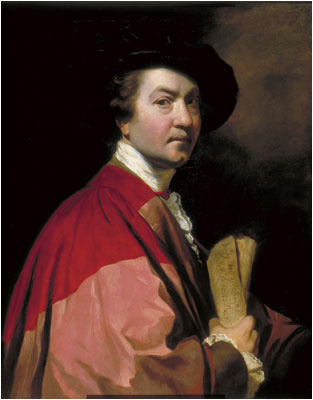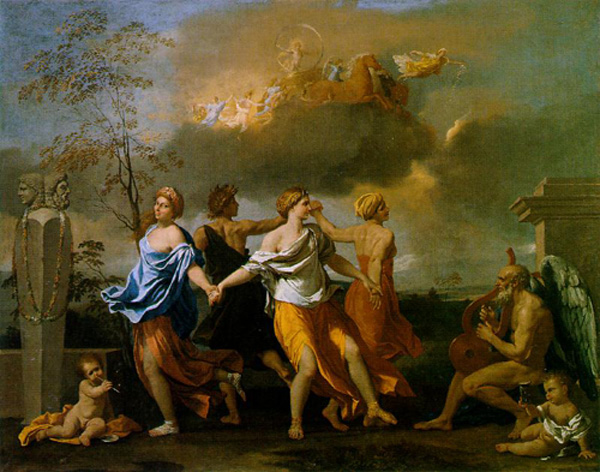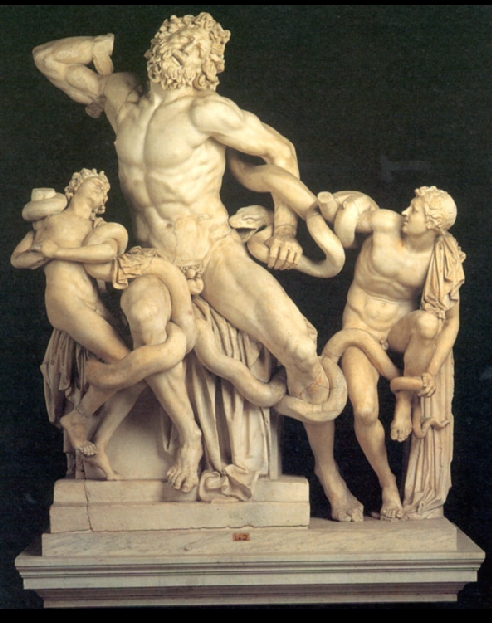Joshua Reynolds, Seven Discourses on Art
The passages below from Reynolds Discourses represent one of the most complete expression of the ideals and assumptions of classicism in art. While the opinions expressed by an English artist in the mid-eighteenth century are not identical to those held by most members of the French academy a century, the general position of both are very similar.
As you read the selections from Reynolds below, ask yourself questions such as:
- What constitutes greatness in art for Reynolds?
- What is the role of training in producing great art?
- What is the ideal relation of the young artist to his teachers and to earlier generations?
- What are relative importance of reason and emotion, training and inspiration in the training of an artist?
- In what ways are his ways of looking at training and inspiration different than those of many people today, who would look to someone like Van Gogh as a model of the artist?
The principal advantage of an academy is, that, besides furnishing able men to direct the student, it will be a repository for the great examples of the art. These are the materials on which genius is to work, and without which the strongest intellect may be fruitlessly or deviously employed. By studying these authentic models, that idea of excellence which is the result of the accumulated experience of past ages may be at once acquired, and the tardy and obstructed progress of our predecessors may teach us a shorter and easier way. The student receives at one glance the principles which many artists have spent their whole lives in ascertaining; and, satisfied with their effect, is spared the painful investigation by which they come to be known and fixed. . . .
This first degree of proficiency is, in painting, what grammar is in literature, a general preparation to whatever species of the art the student may afterwards choose for his more particular application. The power of drawing, modelling, and using colours is very properly called the language of the art; and in this language, the honours you have just received prove you to have made no inconsiderable progress.

Joshua Reynolds, Self-Portrait (1776)

Nicolas Poussin, Dance to the Music of Time (c.1640)
[Poussin was as particular favorite of French classicists, many of whom looked at his work as a kind of ideal of art.]
When the artist is once enabled to express himself with some degree of correctness, he must then endeavour to collect subjects for expression; to amass a stock of ideas, to be combined and varied as occasion may require. He is now in the second period of study, in which his business is to learn all that has hitherto been known and done. Having hitherto received instructions from a particular master, he is now to consider the art itself as his master. He must extend his capacity to more sublime and general instructions. Those perfections which lie scattered among various masters are now united in one general idea, which is henceforth to regulate his taste and enlarge his imagination. With a variety of models thus before him, he will avoid that narrowness and poverty of conception which attends a bigoted admiration of a single master, and will cease to follow any favourite where he ceases to excel. This period is, however, still a time of subjection and discipline. Though the student will not resign himself blindly to any single authority when he may have the advantage of consulting many, he must still be afraid of trusting his own judgment, and of deviating into any track where he cannot find the footsteps of some former master.
The third and last period emancipates the student from subjection to any authority but what he shall himself judge to be supported by reason. Confiding now in his own judgment, he will consider and separate those different principles to which different modes of beauty owe their original. In the former period he sought only to know and combine excellence, wherever it was to be found, into one idea of perfection; in this he learns, what requires the most attentive survey and the subtle disquisition, to discriminate perfections that are incompatible with each other. . . .
It is indisputably evident that a great part of every man’s life must be employed in collecting materials for the exercise of genius. Invention, strictly speaking, is little more than a new combination of those images which have been previously gathered and deposited in the memory. Nothing can come of nothing. He who has laid up no materials can produce no combinations. . . .
To a young man just arrived in Italy, many of the present painters of that country are ready enough to obtrude their precepts, and to offer their own performances as examples of that perfection which they affect to recommend. The modern, however, who recommends himself as a standard, may justly be suspected as ignorant of the true end, and unacquainted with the proper object of the art which he professes. To follow such a guide will not only retard the student, but mislead him.

Jacques-Louis David, The Death of Socrates (1787)
[This is another example of the kind of classicism that many main stream artists in Paris in the second half of the 19th century would have looked back on as a model for their work.]

Ancient statue of Laocoön and his sons (c.25 B.C.)
On whom, then, can he rely, or who shall show him the path that leads to excellence? The answer is obvious: Those great masters who have travelled the same road with success are the most likely to conduct others. The works of those who have stood the test of ages have a claim to that respect and veneration to which no modern can pretend. The duration and stability of their fame is sufficient to evince that it has not been suspended upon the slender thread of fashion and caprice, but bound to the human heart by every tie of sympathetic approbation.
There is no danger of studying too much the works of those great men, but how they may be studied to advantage is an inquiry of great importance. . . .
However the mechanic and ornamental arts may sacrifice to fashion, she must be entirely excluded from the art of painting; the painter must never mistake this capricious changeling for the genuine offspring of nature; he must divest himself of all prejudices in favour of his age or country; he must disregard all local and temporary ornaments, and look only on those general habits that are everywhere and always the same. He addresses his works to the people of every country and every age; he calls upon posterity to be his spectators, and says with Zeuxis, In æternitatem pingo [Paint in Eternity].